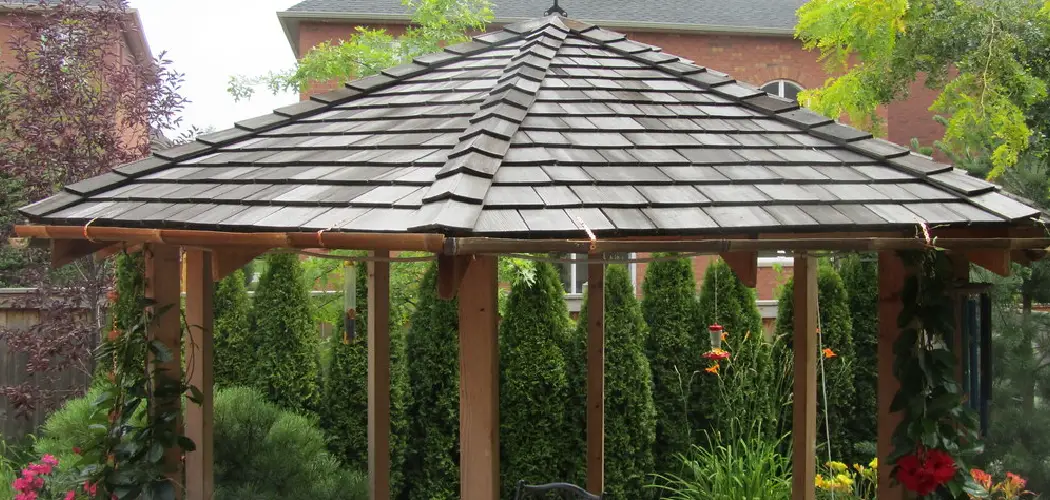A pergola is a great addition to any outdoor living space. Whether used as a gathering place for friends and family or simply as a decorative element, it adds character and charm to your backyard. Unfortunately, if it isn’t properly protected against the elements, it can quickly become damaged by rain, wind, and other factors.
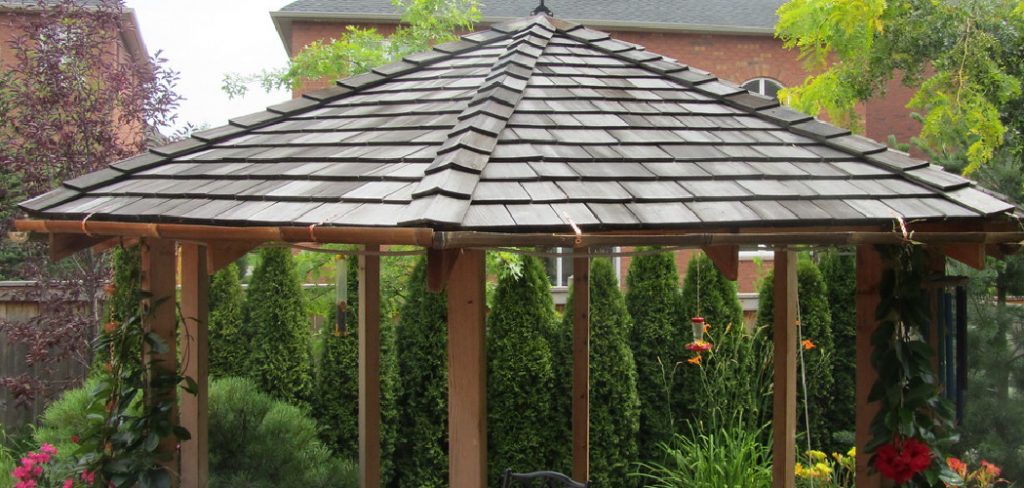
To prevent this from happening, it’s best to make your pergola rainproof. First, consider adding a canopy or roof to your pergola. This will protect you from the rain and allow you to enjoy the outdoors. If you don’t want to add a permanent structure, you can also use a tarp or other waterproof material as a temporary solution.
Another option is to install gutters on your pergola. This will help to channel the rainwater away from your living space and prevent water from pooling on the ground. Finally, ensure that your pergola is properly sealed so that water cannot penetrate the wood or other materials. In this blog post, You will learn in detail how to make a pergola rain proof.
Step-by-Step Processes for How to Make a Pergola Rain Proof
Step 1: Measure the Area
Before starting work on making a pergola rainproof, it is necessary to have the exact area measurements. This will be extremely helpful when selecting materials and creating plans for the project.
Step 2: Choose Materials
Depending on what kind of protection you are looking for, various materials can be used, such as wood, metal, vinyl, or fabric. Make sure to select materials that are weather-resistant and suitable for the project.
Step 3: Select a Cover
Choose from various covers such as canvas, acrylic sheets, shade cloths, or an aluminum roofing material that can be used for making a pergola rainproof. Using the measurements taken in Step 1, construct a frame for the pergola. Make sure to use weather-resistant materials and the high-quality hardware such as stainless steel or galvanized bolts and nuts.
Step 4: Attach the Cover
Once the frame is constructed, attach the chosen cover to the frame using appropriate fasteners. Make sure the cover is securely attached so that it can withstand winds and rainfall. To ensure that the rainwater is collected away from the pergola, install a gutter system along its length. Ensure the gutters are firmly attached and the water is led away from the structure.
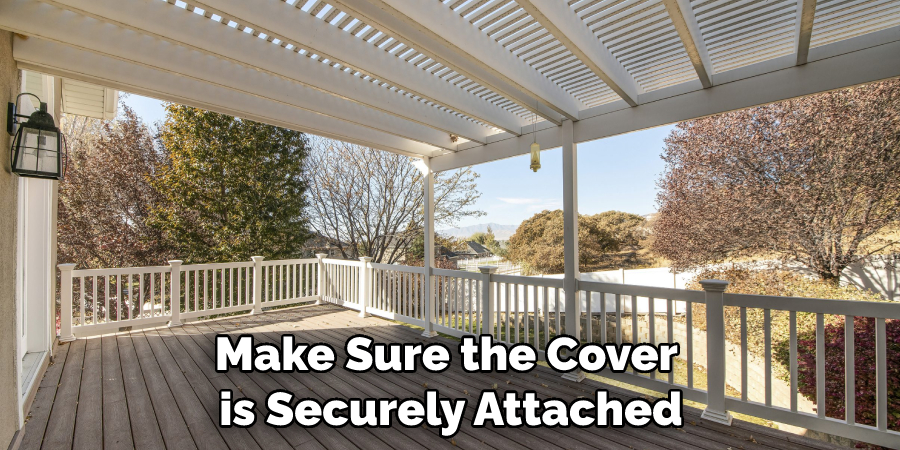
Step 5: Seal all Edges
To ensure no gaps or openings are left in the pergola’s construction, seal all edges with a waterproof sealant or caulk. This will help keep out any moisture and prevent leaks. A louvered roof can be a great way to make a pergola rainproof. The slats can be adjusted to provide shade and protection from the elements while allowing natural light to enter.
Step 6: Cover with Shade Cloth
If you prefer more coverage than the louvered roof, consider covering the pergola with a shade of cloth. This will provide complete protection from the elements and can be removed when needed.
Step 7: Add Decorative Touches
Once your pergola is rainproofed, you can add some decorative touches to make it even more attractive. Adding hanging plants or string lights can create a more inviting and cozy atmosphere.
Tips for How to Make a Pergola Rain Proof
- Wear safety glasses and protective clothing when working with power tools.
- Use a ladder to reach the upper portions of your pergola safely.
- Secure boards firmly with nails or screws, being careful not to overdrive them into the wood.
- Check for rotted wood or exposed nails and replace them as needed.
- Measure and cut the sheets of plastic carefully to ensure they fit correctly.
- Pre-drill holes in the wood before attaching any screws or nails with a power tool.
- Position plastic sheeting against the pergola and fasten it with either staples, screws, or nails while avoiding contact with the electrical wiring.
- Add a fascia board to the top of your pergola to help keep water from pooling on top of the plastic sheeting.
- Apply silicone caulk to all exposed seams and edges where two pieces of plastic meet for an extra layer of protection.
- Secure a tarp over the pergola with ropes, bungee cords, or clips for added protection during rainy days.
Following these tips will help make your pergola rainproof and keep you safe while working on your project.
How Frequently Should You Inspect and Maintain Your Waterproofed Pergola?
Once you have made your pergola rainproof, it’s important to stay on top of its maintenance. Regular inspections and repairs help ensure that the waterproofing stays in good condition. How often should you inspect and repair your pergola?
You Can Check It Out to Put a Roof on a Flat Pergola
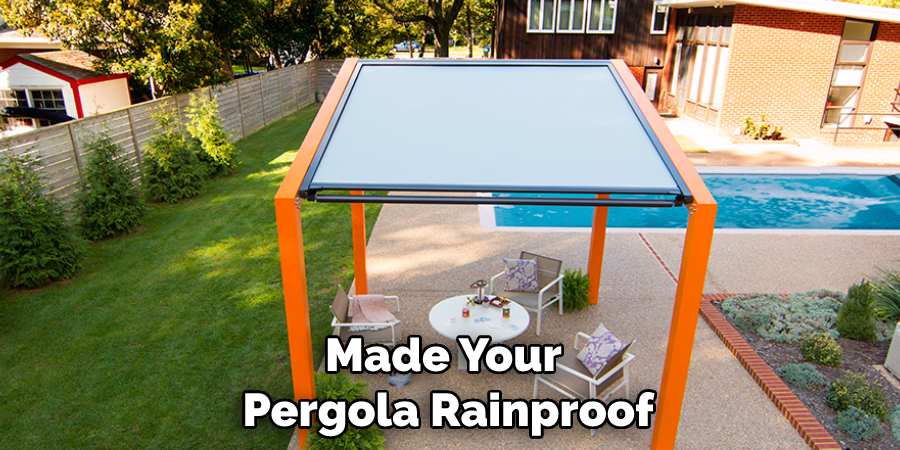
Ideally, you should inspect and maintain your pergola every six months or so. Check for signs of wear and tear, such as cracks, peeling paint, or rust. If necessary, reapply waterproofing products to any areas that need repair. Also, make sure that all components of your pergola are securely fastened. If you live in an area with extreme weather conditions such as strong winds, heavy rain, or hail, you may need to inspect your pergola more regularly. Ensure all bolts and screws are securely tightened, and repair any visible damage as soon as possible.
Inspecting and maintaining your waterproofed pergola regularly will help ensure that it remains in good condition for many years to come. Contact a professional for advice if you have any questions about maintaining your pergola. With proper care and maintenance, you can enjoy the beauty of your pergola’s rainproofed protection for years to come.
How Can You Protect the Underside of Your Pergola From the Rain?
The best way to protect the underside of your pergola from rain is to use a waterproof membrane. How you go about this depends on the type of pergola and your budget. If you have an open-roofed structure, then attaching a waterproof membrane directly to the beams is the most effective way. This will keep out the rain and keep your decking area dry.
If you have a solid roof, then the membrane should be attached to the underside of the beams and covered with an overlay system to protect it from UV rays. You can also install plastic sheeting or tarpaulins to create a waterproof layer for added protection.
Another option is to install gutters around the pergola, which will direct the rainwater away from your deck and into a drainage system. You can also install downspouts that are designed to connect to your gutter system and allow you to divert the water away from your outdoor living space.
Finally, you can install vertical or horizontal louvers if you are concerned about keeping out wind-driven rain. This will allow the wind to flow through but not cause rain to enter your pergola area. By taking these steps, you can ensure that your pergola is protected from the rain and keep your outdoor living space dry and protected. Proper waterproofing allows you to enjoy your outdoor space for many years.
What Type of Sealant Should You Use to Waterproof Your Pergola?
The type of sealant you should use to waterproof your pergola will depend on the material your pergola is made out of. If it’s wooden, then the most common choice is a polyurethane sealant or a water-based acrylic sealer. Both are easy to apply and offer great protection against rain and moisture. Here are some options:
You Can Check It Out to Get Roofing Leads without Door Knocking
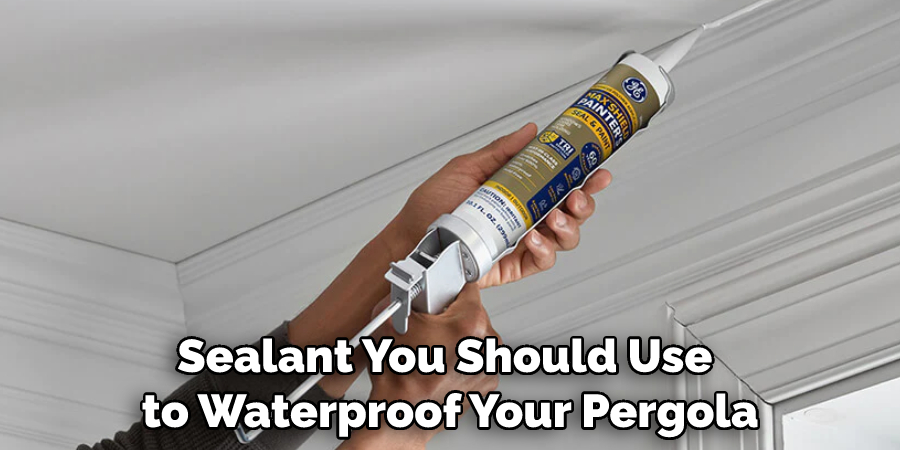
- Silicone Sealant: This type of sealant is best for metal surfaces, as it creates a waterproof barrier that won’t be affected by heat or cold. However, it can be difficult to apply evenly, so it’s important to follow the instructions carefully.
- Latex Sealant: Latex sealants are ideal for wood surfaces as they are easy to apply and provide a flexible, weatherproof seal. However, they must be reapplied regularly to maintain their water resistance.
- Polyurethane Sealant: This type of sealant is one of the most durable options, making it ideal for high-traffic areas. It’s also UV resistant so that it won’t fade in direct sunlight. However, it can be tricky to apply and is best suited for experienced DIYers.
No matter which type of sealant you choose, be sure to follow the instructions carefully to ensure the best results.
How Long Does a Waterproofed Pergola Last?
A well-constructed and waterproofed Pergola can last for many years. Several factors determine the longevity of a rainproofed pergola, including the quality of materials used, its installation, weather conditions, and maintenance.
High-quality materials such as cedar or redwood are more durable than other, less expensive materials and can last for decades with proper upkeep. The structure must also be installed correctly to ensure that it won’t decay or rot over time due to water pooling or improper drainage.
Additionally, the weather in your area will play a critical role: areas with high humidity levels require more attention and maintenance than drier climates.
Proper maintenance is also key for a long-lasting, waterproofed pergola.
Make sure to inspect the structure periodically for any signs of rot or decay, and treat the wood with preservatives or sealers as needed. Regular cleaning will also help keep your pergola looking great and prolong its life span. Your waterproofed pergola should last many years with proper care and maintenance.
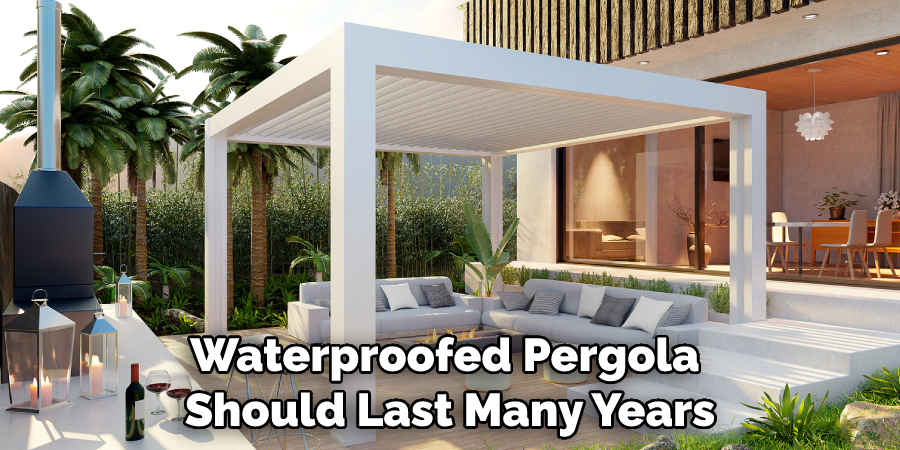
Conclusion
Making a pergola rainproof can be challenging, but several effective solutions can be used to protect your outdoor space. Utilizing waterproof covers or polycarbonate sheets is an ideal way to protect the area from water and other elements. Alternatively, if you want a more permanent solution, adding gutters and downspouts around the pergola can be extremely effective at keeping water away from your structure.
No matter what solution you choose, taking the time to make a pergola rainproof will help extend its lifespan and keep your outdoor space dry and comfortable in any weather conditions. I hope this article has been beneficial for learning how to make a pergola rain proof. Make Sure the precautionary measures are followed chronologically.
You Can Check It Out to Protect Ipe Wood Deck

